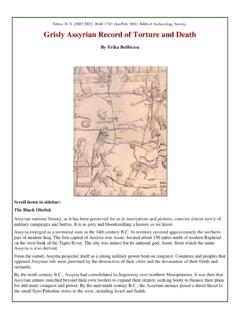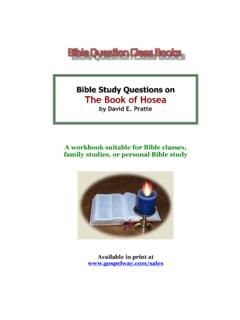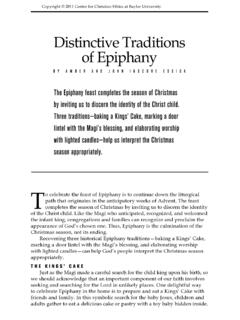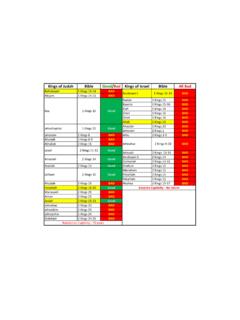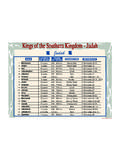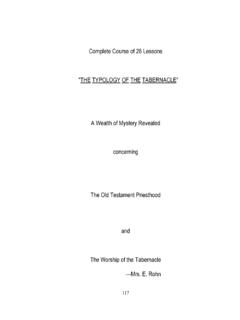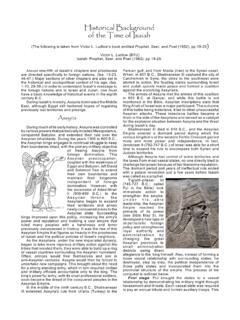Transcription of E13 - Samuels-Kings-Chronicles - ctrussell.fr
1 EPIPHANY STUDIES IN THE SCRIPTURES "The Path of the Just is as the Shining Light, That Shineth More and More Unto the Perfect Day." SERIES XIII SAMUELS KINGS CHRONICLES (With An Appendix) 7,000 EDITION "Which of The Prophets have not your Fathers Persecuted?" (Acts 7:52). PAUL S. L. JOHNSON As Executive Trustee of The Laymen's Home Missionary Movement PHILADELPHIA, PA., U. S. A. 1949 _____ To the king of Kings and lord of lords IN THE INTEREST OF HIS CONSECRATED SAINTS, WAITING FOR THE ADOPTION, AND OF "ALL THAT IN EVERY PLACE CALL UPON THE LORD;" " THE HOUSEHOLD OF FAITH." AND OF THE GROANING CREATION, TRAVAILING AND WAITING FOR THE MANIFESTATION OF THE SONS OF GOD, THIS WORK IS DEDICATED. "To make all see what is the fellowship of the mystery which from the beginning of the world hath been hid in God," "Wherein He hath abounded toward us in all wisdom and prudence, having made known unto us the mystery of His will, accord- ing to His good pleasure which He hath pur posed in Himself; that in the dispensation of the fulness of the times He might gather together in one all things, under Christ.
2 " Eph. 3: 4, 5, 9: 1: 8-10. COPYRIGHT 1949 By PAUL JOHNSON As Executive Trustee of The Laymen's Home Missionary Movement ii AUTHOR'S FOREWORD IT IS the design of this volume of the Epiphany Studies in the Scriptures to set forth the antitypes of the books of Samuel, Kings and Chronicles, with the exception of those parts of them that treat of David and Solomon. Those parts of these books that treat of David are given, as to their small antitype, in the two volumes of this work entitled "The Parousia Messenger." Those parts of these books that treat of Solomon will, as to their small antitype, be discussed, D. v., in a chapter that is to be added to another volume of this work. The present volume treats first, of antitypical Samuel in two chapters; then of antitypical Samuel and Saul in one chapter.
3 Thereafter it gives the antitypes of the kings of Israel and judah insofar as they concern their large parallels. We say large parallels, in which the years in the lives of these are paralleled by the years of certain Gospel-Age movements just 2520 years later, because there is a small parallel in which the years of these kings are paralleled by days in the Epiphany. This small parallel has been explained in EJ, chapter 6. It might be added that there is a third set of antitypes of the kings of judah and Israel, that is, certain specialized antitypes, for example, Elijah as the type of the Church as God's reformer-mouthpiece to the world from Jordan to its final deliverance, Elisha as the type of the Great Company and Youthful Worthies, first, as the servants of the Church until it lost mouthpieceship to the world, and thereafter, as God's mouthpiece to the world, particularly as Societyites.
4 There are numerous other specialized antitypes in these books. In the appendix we treat briefly of the specialized antitype of Athaliah and Joash and their acts. The first part of the appendix treats of the Gospel-Age antitypes of lamentations set forth in Lam. 1-5. From the above it can be readily inferred how rich in typical teachings the six books treated of in this volume are. That the two books of Samuel and the two books of Kings are typical, and that typically prophetic, is evident from the fact that, in the Hebrew Old Testament, they belong to its second division, which is in Hebrew called The Prophets. This division has two parts, the first, the iii books from Joshua to 2 Kings inclusive, being by God called The Earlier Prophets, and the second, consisting of Isaiah, Jeremiah, Ezekiel and the twelve minor prophets, is there called The Later Prophets.
5 From what Peter said (Acts 3: 24) we infer that Samuel, the first of the line of prophets, wrote Joshua, Judges and Ruth, and from 1 Chro. 29: 29, we infer that he wrote the bulk of 1 Sam. The questions arise, Why does God call the former set of books "Earlier Prophets" since they are historical in character, and how could the inspired Peter refer to these four books, as well as to the rest of these historical books, as Prophets? The reply to these questions is that they are prophetic. They are histories that give prophetic types, that is, types that foretell future persons, events and things. From this fact we infer that 1 and 2 Chro., treating of the same general events, are also typically prophetic. It is these facts that have moved the author to study these books as types of future things in the unfolding plan of God, and to set forth his Divinely illuminated findings thereon in this volume.
6 That upon its ministry God may richly bestow His blessing is the prayer of its author. Your brother and servant, PAUL S. L. JOHNSON. Philadelphia, PA., July 7, 1945. iv CONTENTS. PART I. ISRAEL'S FIRST PROPHET AND king . CHAPTER I. SAMUEL. 1 Sam. 1-4. PRENATAL EXPERIENCES. BIRTH AND BOYHOOD. EVIL PRIESTS. EARLYACTIVITIES AS PROPHET. THE FIRST BATTLE. THE SECOND BATTLE.. 7 CHAPTER II. SAMUEL (Continued). 1 Sam. 5-8. THE ARK AT ASHDOD; AT GATH; AT EKRON. WORK OF THE PHILISTINE LORDS. BETH-SHEMITES. KIRJAH-JEARIMITES. WAR WITH THE PHILISTINES. DESIRING A king ..83 CHAPTER III. SAMUEL AND SAUL. 1 Sam. 9-15. SAUL MADE king . HIS VICTORY OVER NAHASH. SAMUEL'S VINDICATION AND EXHORTATIONS. SAUL'S FIRST WAR WITH THE PHILISTINES. HIS DISOBEDIENCE..181 PART II. LARGE PARALLELS OF judah 'S AND ISRAEL'S KINGS.
7 V CHAPTER IV. EARLIER PARALLELS. 1 Kings 12: 1-2 Kings 8: 29; 2 Chron. 13: 1-22: 5. CHRONOLOGICAL HARMONIES. EARLIER PARALLEL PROTESTANT MOVEMENTS. THEIR MANY CONTROVERSIES, ANTITYPICAL ELIJAH AND ELISHA.. 273 CHAPTER V. SOME MIDDLE PARALLELS. 2 Kings 9-11: 21; 13: 1-23; 14: 15, 16; 23-29; 15: 8-12; 2 Chron. 22: 10-23: 21. JEHU. JEHOHOAZ. JEHOASH. JEROBOAM II. ZACHARIAH. ATHALIAH. JOASH.. 383 CHAPTER VI. OTHER MIDDLE PARALLELS. 2 Kings 11: 21-12: 21; 12: 1-14, 17-20; 2 Chron. 24: 1-25: 28. JOASH (OF judah ). AMAZIAH. WAR BETWEEN AMAZIAH AND JOASH (OF ISRAEL).. 471 CHAPTER VII. LATER PARALLELS. 2 Kings 14: 21-17: 41; 18: 9-12; 2 Chron. 26: 1-28: 27. UZZIAH. JOTHAM. AHAZ. SHALLUM. MENAHEM. PEKAHIAH. PEKAH. AHAZ. HOSHEA.
8 527 CHAPTER VIII. LAST PARALLELS. HEZEKIAH. MANASSEH. AMON JOSIAH. JEHOAHAZ. JEHOIAKIM. JEHOIACHIN, ZEDEKIAH.. 619 vi CHAPTER I SAMUEL 1 SAM. 1-4 PRENATAL EXPERIENCES. BIRTH AND BOYHOOD, EVIL PRIESTS. EARLY ACTIVITIES AS PROPHET. THE FIRST BATTLE. THE SECOND BATTLE. WE WILL, as the first part of this book, study the first 15 chapters of 1 Sam., and that under the following two titles: (1) Samuel Type and Antitype (1 Sam. 1 8), and (2) Samuel and Saul type and Antitype (1 Sam. 9 15). Accordingly, in this and the following chapter we will study the first subject, and, after finishing it, we will study the second subject in the third chapter, God willing and prospering our study. As elsewhere indicated, our typical expositions will be made terser than those usually hitherto given.
9 Otherwise we will be unable to accomplish the Lord's will for the Epiphany messenger, that he explain everything in the Bible not explained by the Parousia messenger. We will not find the Samuel antitype to follow throughout a progressive, chronological sequence of events. Rather, the first 15 chapters of the book give us, especially in its first eight chapters, a series of Gospel-Age pictures of certain events more or less disconnected chronologically from one another, though more or less connected in general lines of thought. Thus the events of 1 Sam. 1 and 2 give us a chronological picture of certain related events, more or less separate and distinct from those that follow. As we go on we will point out in each case the changes from one to the other set of pictures. The general setting of 1 Sam. 1 and 2 will first be given.
10 It treats of the elect classes, especially of the Little Flock, in the end of the Age. The antitype in general outlines is like that of Jacob, his wives and his children, with certain differences to bring out thoughts not found in the Jacob 7 8 Samuels Kings Chronicles. picture. In this story, generally speaking, Elkanah corresponds to Jacob, Peninnah to Leah, Zilpah and Bilhah, and Hannah to Rachel, with certain elaborations not found in the Rachel picture. We have seen that in his family matters Jacob types the Gospel-Age star-members and their special helpers; Leah, Zilpah and Bilhah certain truths and the servants who applied them to the members of the ten denominational groups of Christendom; Rachel the elective truths and the servants who applied them to the Little Flock and the Great Company in the end of the Age the Parousia and the Epiphany; Joseph the Little Flock in the Parousia movement and Benjamin the Great Company in the Epiphany movement.
